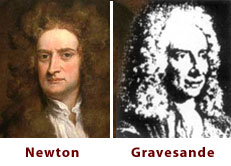17th
through 19th Centuries
Rocketry as
a Science
 During
the latter part of the 17th century, the scientific foundations that apply to
all modern rocketry were laid by the English scientist Sir Isaac Newton
(1642-1727). Newton expressed his understanding of physical motion via three
scientific laws. The laws explain how rockets work and why they are able to
function in the vacuum of outer space. Newton's laws had a practical impact
on the design of rockets. About 1720, a Dutch professor, Willem Gravesande,
built model cars propelled by jets of steam. At the same time, rocket experimenters
in Germany and Russia began working with rockets of greater and greater mass.
Some of these rockets became so powerful that their escaping exhaust flames
bored deep holes in the ground even before liftoff.
During
the latter part of the 17th century, the scientific foundations that apply to
all modern rocketry were laid by the English scientist Sir Isaac Newton
(1642-1727). Newton expressed his understanding of physical motion via three
scientific laws. The laws explain how rockets work and why they are able to
function in the vacuum of outer space. Newton's laws had a practical impact
on the design of rockets. About 1720, a Dutch professor, Willem Gravesande,
built model cars propelled by jets of steam. At the same time, rocket experimenters
in Germany and Russia began working with rockets of greater and greater mass.
Some of these rockets became so powerful that their escaping exhaust flames
bored deep holes in the ground even before liftoff.
Toward the
end of the 18th century and early into the 19th, rockets experienced a brief
revival as a weapon of war. The success of Indian rocket barrages against the
British in 1792 and again in 1799 caught the interest of an artillery expert,
Colonel William Congreve, who set out to design rockets for
use by the British military.
 The
Congreve rockets were highly successful in battle. Used by British ships to
pound Fort McHenry in the War of 1812, they inspired Francis Scott Key
to write about "the rockets' red glare" in his poem, "The Siege of Fort
McHenry," which we know today as "The Star-Spangled Banner."
The
Congreve rockets were highly successful in battle. Used by British ships to
pound Fort McHenry in the War of 1812, they inspired Francis Scott Key
to write about "the rockets' red glare" in his poem, "The Siege of Fort
McHenry," which we know today as "The Star-Spangled Banner."
Even with
Congreve's work, the accuracy of rockets still had not improved much from the
early days. The devastating nature of war rockets during this era was not their
accuracy or power, but their numbers. During a typical siege, thousands of them
might be fired at the enemy. The effects of such a rain of rockets could be
devastating! All over the world, rocket researchers experimented with ways to
improve accuracy. The Englishman William Hale developed a technique
called spin stabilization, in which the escaping exhaust gases
expanded through small vanes at the bottom of the rocket, causing it to spin
much as a bullet does in flight. Variations of this principle are still used
today.
Rockets continued
to be used with success in battles all over the European continent. However,
in a war with Prussia, the Austrian rocket brigades met their match against
newly designed artillery pieces. Breech-loading cannon with rifled barrels and
exploding warheads were far more effective weapons of war than the best rockets.
Once again, rockets were relegated to peacetime uses.
Close
Window
 During
the latter part of the 17th century, the scientific foundations that apply to
all modern rocketry were laid by the English scientist Sir Isaac Newton
(1642-1727). Newton expressed his understanding of physical motion via three
scientific laws. The laws explain how rockets work and why they are able to
function in the vacuum of outer space. Newton's laws had a practical impact
on the design of rockets. About 1720, a Dutch professor, Willem Gravesande,
built model cars propelled by jets of steam. At the same time, rocket experimenters
in Germany and Russia began working with rockets of greater and greater mass.
Some of these rockets became so powerful that their escaping exhaust flames
bored deep holes in the ground even before liftoff.
During
the latter part of the 17th century, the scientific foundations that apply to
all modern rocketry were laid by the English scientist Sir Isaac Newton
(1642-1727). Newton expressed his understanding of physical motion via three
scientific laws. The laws explain how rockets work and why they are able to
function in the vacuum of outer space. Newton's laws had a practical impact
on the design of rockets. About 1720, a Dutch professor, Willem Gravesande,
built model cars propelled by jets of steam. At the same time, rocket experimenters
in Germany and Russia began working with rockets of greater and greater mass.
Some of these rockets became so powerful that their escaping exhaust flames
bored deep holes in the ground even before liftoff.  The
Congreve rockets were highly successful in battle. Used by British ships to
pound Fort McHenry in the War of 1812, they inspired Francis Scott Key
to write about "the rockets' red glare" in his poem, "The Siege of Fort
McHenry," which we know today as "The Star-Spangled Banner."
The
Congreve rockets were highly successful in battle. Used by British ships to
pound Fort McHenry in the War of 1812, they inspired Francis Scott Key
to write about "the rockets' red glare" in his poem, "The Siege of Fort
McHenry," which we know today as "The Star-Spangled Banner."